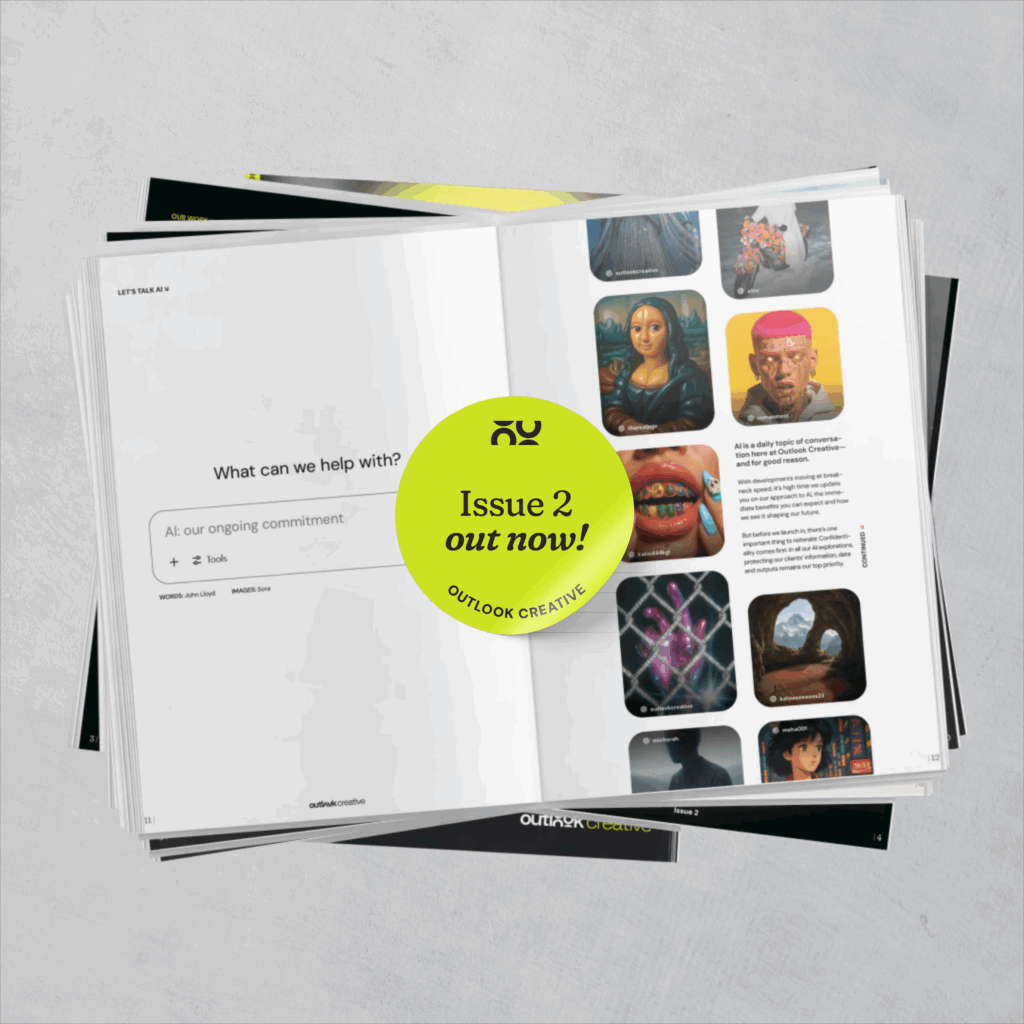
AI voiceovers are advancing at a rate of knots, and it’s easy to see why. They’re practical, efficient and can save serious time, especially when used in the right context.
What’s clear is that they’re a valuable addition to the creative process. An addition that means we have more tools in our toolkit than ever before. But rather than replacing what already works, AI voiceovers simply expand the options available.
For some projects, a human voice will be the natural choice; for others, AI may prove the smarter option—and often, a blend of the two can work marvellously. Our role in all of this is to help you work out which approach delivers the best results for your audience, timeline and budget.
…That’s the theory. Now for the practice.
We wanted to explore just how far AI voice tech has come. So we used our enterprise AI models to build a simple demo using a non-actor’s voice: one script, two reads—first by the human, then by an AI clone of the same voice. The example switches seamlessly between them.
What do you think?
Note: we used a fictional diabetes product script to show how AI handles medical terms. Any likeness to real products is purely coincidental.
This isn’t about replacing human voiceovers or picking sides. It’s about giving you more choice. We audition and sample both human and AI reads on your script so you can hear the difference for yourself.
Sometimes a human voice carries instinct, emotion or nuance that just clicks. Other times, technology can surprise you with speed, consistency and unexpected flow. Often, the magic happens somewhere in between.
Of course, AI isn’t flawless. Longer reads can get tricky, clones can shift between sessions, and technical language or names need a careful touch. Rights and transparency matter too—check out the EU AI Act for more on this.
But that’s where we come in: building glossaries, setting pronunciation guides, running quality checks and making sure that every voice is used with clear consent. By handling these details, we keep AI reliable, consistent and safe to use so you can make the most of what’s possible.
We’re here to remove faff and add value. Great work doesn’t come from tools alone; it comes from the choices we make. Our job is to help you make the right ones for your project, every time.
It feels like only yesterday we launched the first edition of this magazine—but as the relentless march of time keeps reminding us, a lot can happen between ‘just now’ and ‘right now’. Especially in our world, where the pace of change—particularly in AI and audience engagement—feels less like a steady evolution and more like a rocket launch.
The response to our first issue? Genuinely overwhelming (in the best way). Thank you. Your feedback has spurred us on to keep sharing more of what makes Outlook Creative tick—because this magazine isn’t just a showcase of the work we do, it’s a reflection of who we are. As a business. As individuals. As people who live and breathe creative problem-solving.
Inside, you’ll find a mix of insight and opinion—our take on the ever-evolving industry we work in, from the rise of AI to new approaches in event engagement. You’ll also get a peek at some of the incredible client work we’ve been involved in (well, the bits we’re contractually allowed to share!).
Whether it’s thoughts on this edition or ideas for future ones, feedback is always welcome. And if anything in here sparks a conversation—about a project, a challenge, or just a curious ‘what if?’—we’re always up for that, too.

We won’t name names, but a trusted colleague of ours once said, “Success lies in making the complex seem effortless.” Stick it on a plaque.
For us, that idea of making the complicated look easy is more than an aspiration; we treat it as a commitment. It’s something that drives every project we turn our hand to, especially when it comes to events.
Whether it’s 15 delegates in a boardroom or thousands of attendees at an exhibition, we thrive on managing the behind-the-scenes stuff that makes most people sweat. Think last-minute changes, technical complexities, multiple moving parts, all handled seamlessly to deliver an event experience that’s memorable for all the right reasons.
But rather than us blowing our own trumpet, let’s get into the specifics. When we say “We make events easy”, here’s what that really means—and how it makes a difference for our clients.
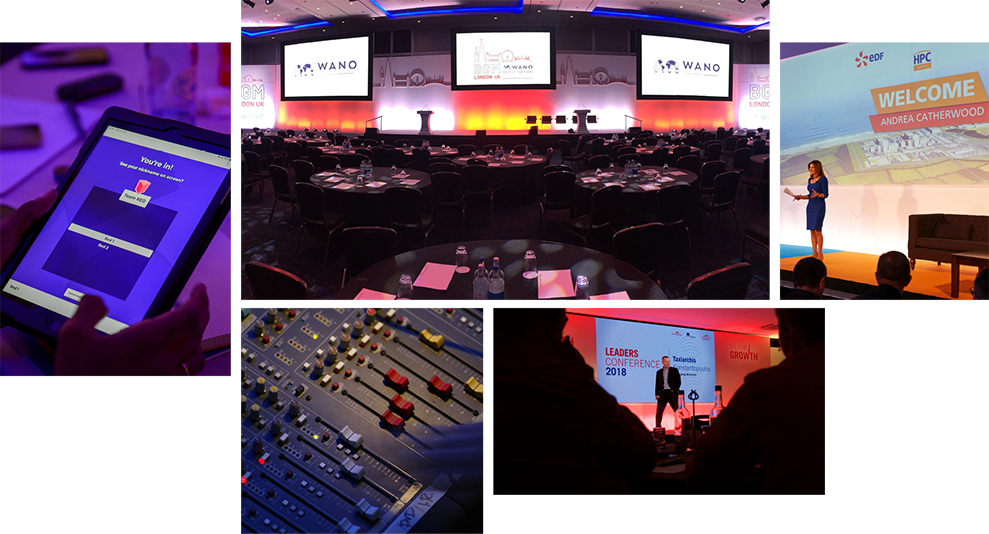
Let’s be honest, events can be complex beasts. From venue negotiations and safety protocols to that one specific lighting fixture you absolutely must have, there’s a lot to juggle.
…which is industry speak for: “A logistical nightmare that keeps you awake at 3 am.”
But not on our watch. Your dedicated project manager becomes your event ally, handling everything from initial concept to final teardown. That includes everything else that comes with it: nailing down the perfect theme, developing your comms strategy, producing your event collateral—you name it, they take care of it.
They know your vision inside and out, anticipate your needs before you even voice them and, most importantly, they’re just one call away.* Always.
*Just, please, don’t call at 3 am. We need our beauty sleep…
Remember when you had to explain your vision using hand gestures and hope for the best? Well, those days are gone. Our 3D wizardry, flythrough animations and AI-assisted toolkit mean we can bring your event experience to life before a single piece of equipment arrives on site.
It’s not just pretty pictures; it’s practical magic.
Spot issues, make tweaks and perfect your vision, all before spending a penny on setup. We’ll show you exactly what to expect, so there are no on-the-day surprises. And, what’s more, we’re fully maximising AI’s potential to make your stands and visuals better, quicker and cheaper. Just look at what our Joint MD had to say.
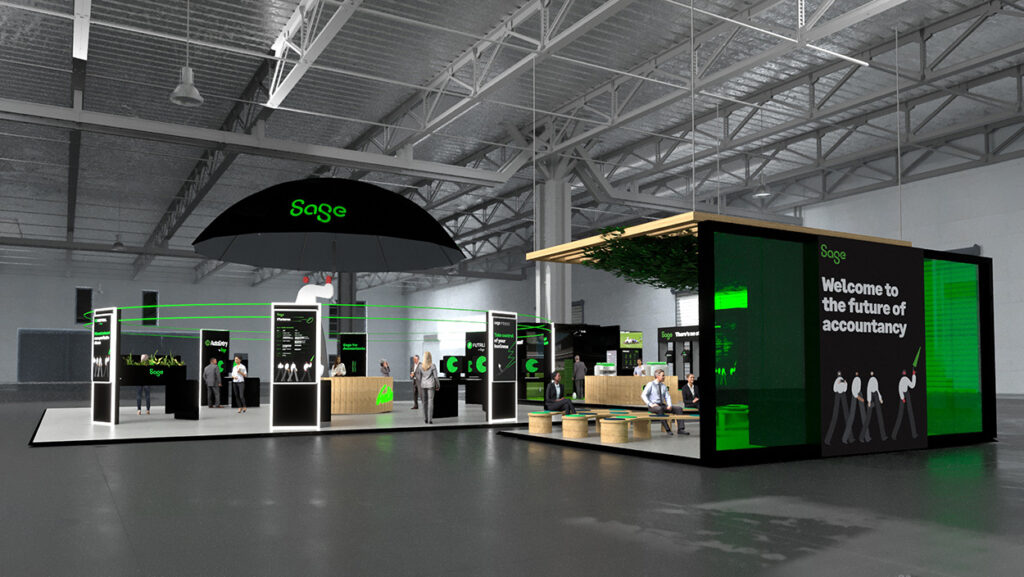
Great events need great content, but who has time to coordinate designers, animators and tech teams while managing everything else?
Psst… the answer’s us. We do.
The team orchestrates everything from creating template files to lay solid foundations, through to handling formatting inconsistencies and last-minute changes, making sure that your content performs flawlessly when the spotlight hits.
Our producers rehearse transitions, test every video and create backup plans for your backup plans. Because in live events, “it should work” just isn’t good enough.
Events aren’t just about what happens on the day—they’re about the story you tell before, during and after.
This is where our Creative team really shines. We take the time to understand your objectives, your audience and what makes them tick. Then, we craft messaging that connects. Sometimes it’s a surprising statistic that changes perspective; other times it’s a personal story that tugs at heartstrings. Often, it’s an interactive element that turns passive listeners into active participants.
Whatever approach we take, the result is the same: an unforgettable message that stays with your audience long after the event ends.
The world has changed and so have events. Whether you’re going fully virtual or creating a hybrid experience, we’ve got you covered.
We’ve all been to virtual events where technical issues, poor production values or clunky interfaces created more barriers than bridges. We do things differently. Our technical know-how makes remote attendees feel like they’re in the front row.
But technology is just the beginning. We also reimagine how content is delivered for digital audiences, incorporating interactive elements, shorter segments and engagement tools that keep remote attendees just as invested as those in the room.
So, there you go. Our comprehensive, collaborative and remarkably easy approach to events. Got one on the horizon? Drop us a line and let’s chat about how we can make your next event the easiest—and most impactful—you’ve ever produced.
Recently, our very own Adam Sherlock, Corey R., and Rebecca Darley shared why the secret sauce to unforgettable events isn’t found in algorithms alone—but in human imagination, playfulness, and creativity.
When you try to narrow down what makes a great event, words like connection, excitement and creativity spring to mind.
But what about fun? When we really gave it some thought, it seemed to us that fun—or more specifically, playfulness—is a crucial yet often overlooked element of what makes an event memorable for all the right reasons. When used well, it has transformative potential, turning a run-of-the-mill experience into something truly unforgettable.
Playfulness can be a powerful tool. But, speaking of powerful tools, how does it fit in with the biggest buzzword on everyone’s lips right now?
We’re talking, of course, about AI.
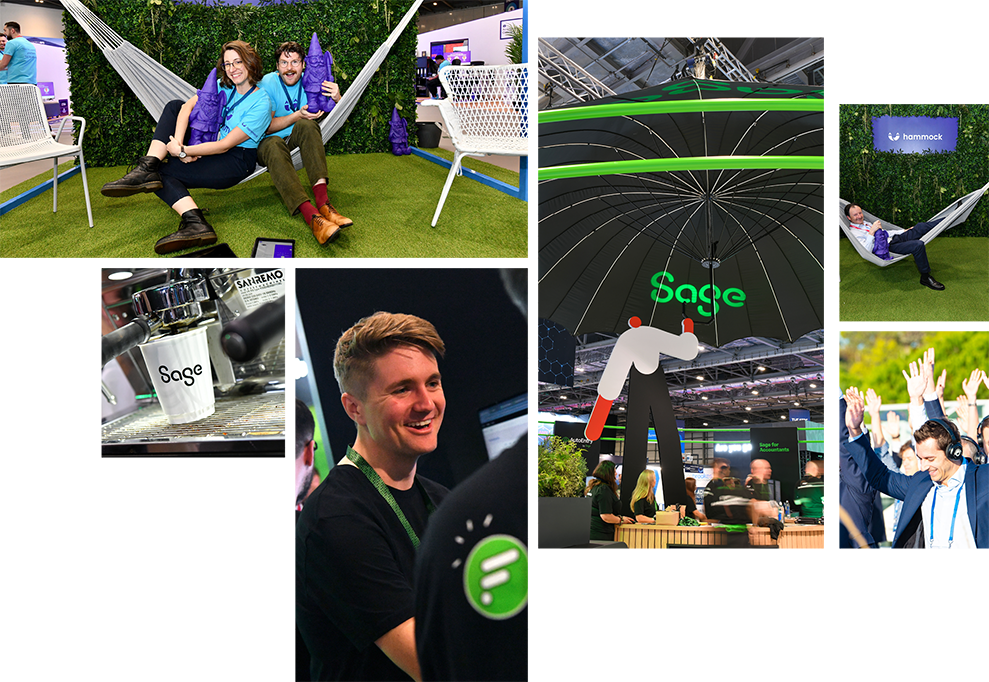
As a word, ‘play’ is difficult to neatly define precisely because it encompasses so many different activities, contexts and purposes. So, rather than us sit here and try, we’ll go straight to the experts.
Peter Gray, Professor of Psychology at Boston College, argues that ‘play’ has four defining characteristics:
It’s easy to see the connections between AI and those first three characteristics in particular:
But it’s that fourth point we really want to home in on. Can AI replicate the creativity and imagination of the human brain when it comes to playfulness?
We’d argue that, no, it can’t.
Back to events—or more specifically, great events. Think back to your last memorable exhibition: Was it the tech alone that made it stand out, or was it something more personal and unexpected? Often, it’s a clever idea dreamed up by someone who understands what genuinely resonates with people.
Take our stand for Sage at Accountex. The idea for our centrepiece (a GIANT umbrella, representing the uniting of their brands under one… well, umbrella) came straight from our very own brains. It was human imagination that sparked the idea, and human graft that delivered a quirky, fun and inviting experience that attendees simply couldn’t resist snapping a picture of.
Sure, we could have used AI to help generate a similar concept, but it’d have been nowhere near as good. Aside from the sheer scale of the thing, it was the subtle human understanding of humour, context and emotional connection that made it such a talking point.
That’s the thing with AI. It supports, but it doesn’t create. At least, not in the same way that we do.
What AI does really well is amplify human ideas. It also helps boost efficiency in the planning stages—things like rapid idea generation, fast visualisation, and predictive analytics are invaluable when it comes to streamlining our processes.
Crucially, the more streamlined our processes, the more time we have to push creative boundaries.
It’s a collaborative relationship, not a competitive one. The best event ideas, the ones that spark laughter, delight and connection, will always need a human touch. No amount of algorithmic planning alone can generate the genuine buzz of good, old-fashioned fun.
So, where does this leave us?
AI undoubtedly offers exciting new possibilities for event planning, helping us refine and execute our playful, creative ideas. But it’s authentic, spontaneous human interactions that create the real power of play at events. While AI is a valuable assistant, it’s never the star of the show.
At Outlook Creative, we believe in playful partnerships—human imagination, supported by smart AI. The future belongs to those who can harness AI’s strengths while never losing sight of what makes events truly unforgettable: creativity and human connection.
After all, you can programme AI, but you can’t programme genuine fun.
Now, excuse me while I go and ask ChatGPT how to fix my boiler.
Feeling inspired? Let’s bring some FUN to your next project. Get in touch to see how we can collaborate.
AI is a daily topic of conversation here at Outlook Creative—and for good reason. With developments moving at breakneck speed, it’s high time we update you on our approach to AI, the immediate benefits you can expect and how we see it shaping our future.
But before we launch in, there’s one important thing to reiterate: Confidentiality comes first. In all our AI explorations, protecting our clients’ information, data and outputs remains our top priority.
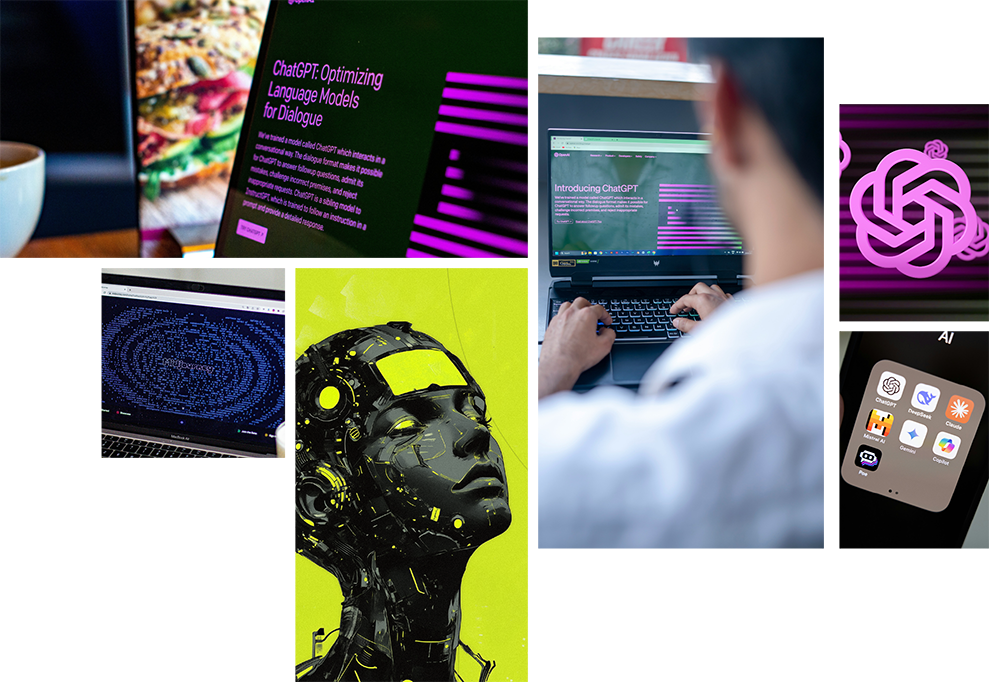
As an agency, we’re committed to using the latest and most advanced software, many of which have integrated AI into their latest offerings. All our production teams have access to these tools, and we’re already seeing the benefits in the speed and quality of outputs.
We’re still working on quantifying this in detail, but early data suggest that both cost per asset and the average overall project cost are decreasing.*
There’s a growing list of ‘quick wins’ facilitated by AI. Let’s get into them.
Voiceovers
AI voiceovers have come a long way in recent months. Historically, our view was that they weren’t quite good enough. But now they are, we’re looking at how we can take full advantage to reduce your costs. On average, we’re currently seeing cost reductions of 50–80% when using AI voiceovers—and much shorter lead times.
For the avoidance of doubt, there’s absolutely still a place for human voiceovers. But there’s also now one for AI-generated alternatives, too.
Moving forwards, for all projects requiring a voiceover, we’ll provide you with both options. The decision will always be yours to make.
LinkedIn
We know video posts perform better on LinkedIn—they get 5x more engagement on average. And with research suggesting that around 30% of people are auditory learners, adding voiceover can help make your message more memorable, accessible and effective.**
Given that AI voiceovers now provide a quality, more cost-effective solution, the team will now provide you with the option of an AI voiceover to support your LinkedIn assets. Again, this is your choice, but we will always give you the option.
Social assets, including LinkedIn
We’re also seeing some encouraging results when we take static social posts and animate them using AI, and we have a feeling that this will soon be ready for us to suggest as a matter of course. Once we get there, the team will routinely ask if you’d like to add animated versions of your static social posts to the assets we produce. Again, your choice.
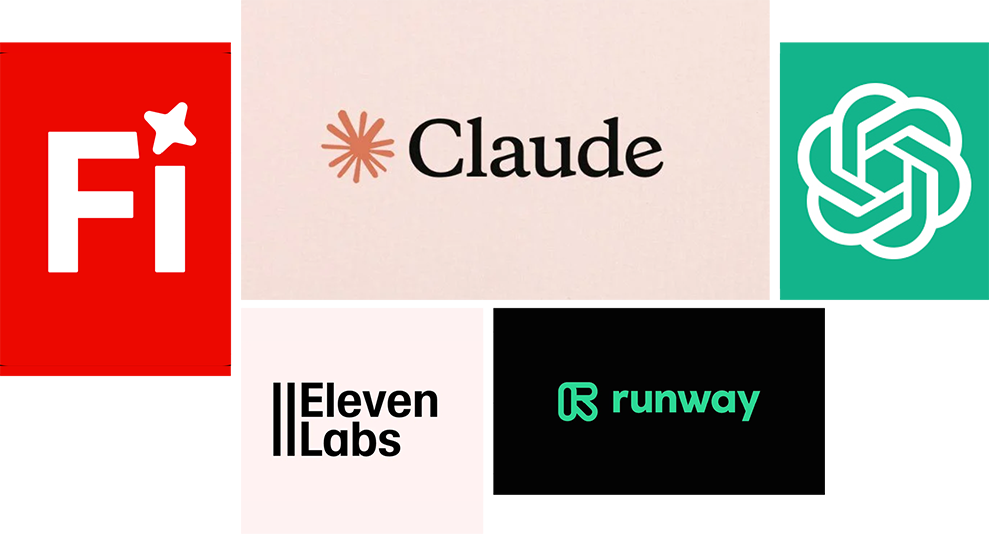
We’ve formed an internal AI Action Group—a cross-agency team that pilots and tests new AI solutions as they emerge and meets regularly to discuss their findings.
It’s easy to get drawn in by the big, shiny applications of AI—and we have an eye on that. Our team is focusing on tangible, real-world applications that support your need for efficient, cost-effective solutions. Our efforts are underpinned by a ring-fenced fund dedicated to AI research.
Ongoing pilots include but are not limited to: ElevenLabs, Midjourney, Runway, Copilot, Claude, Descript, Adobe Firefly and ChatGPT. Some of you may have already received AI-generated meeting notes and actions to support effective project management.
Please note: These pilots are being conducted with confidentiality considerations as a top priority.
It would be very easy to make big, bold and profound predictions. However, the reality is that in this field, there’s still a lot to play out.
In the last few weeks alone, we’ve seen global news stories about the emergence of new AI being developed for a fraction of the cost—with even more capabilities. It feels likely that this is a story that will continue long into the future.
We also predict that AI technology will increasingly begin to migrate towards core products. The integration of AI into long-standing, trusted industry software is already happening, making further advancements surely inevitable. As a result, we expect any outstanding legal questions around licensing, usage, copyright and the legalities of AI-generated content to be resolved.
In the meantime, however, we must look to take advantage of AI within sensible risk parameters.
What’s for sure is that we intend to fully embrace this technology and explore all that it can offer our industry and the service we provide to you.
We’d love to hear from you if you have questions, ideas or thoughts. I’ve provided a link below for you to do just that.
*Based on a cross-section of example projects delivered in 2024 compared to previous years.
Recently, our Joint MD, Adam Sherlock shared some thoughts on AI’s role in revolutionising trade stand management and congress design. And he’s spot on—rather than ‘smuggling AI’ into the workplace we need to find the right ways to explore this next step.
Congresses are one of my favourite sectors within the creative industry. The vibe is different—multiple suppliers, all in the same space, showcasing their work.
We all appreciate a ‘standout’ stand—the unique design, the most engaging experience, or even just the one with the best giveaways. But what was the journey that stand went on? And what role has AI played in its development?
Adapting and implementing AI across much of what we do is no longer a choice—it’s a necessity. Initially, creatives saw AI as a threat to the norm, but resilience and adaptability are in our DNA. The focus has since shifted to maximising AI’s potential and improving our offering to clients.
We’re all using AI to some degree—sometimes even in secret. I recently read a BBC article about employees ‘smuggling AI’ into the workplace. Businesses that restrict exploration will surely be left behind. At Outlook Creative, we’ve launched an AI action group to explore its evolution together.
We thrive on disruption and breaking patterns—something AI has yet to fully master. It’s often said that AI lacks personality. However, what it does offer is an invaluable tool to accelerate projects and push creative boundaries.

The fun part. Brief received. Pencils at the ready.
The phrase ‘sketching on the back of a cigarette packet’ may be lost on some, but some of the best ideas have started this way. From early iterations to days of tweaking in the studio, the ideation stage has always been an exciting process.
This is also where AI can work its magic. Quick-hit ideas provide a great starting point and help steer creative direction. Anyone who has attempted to design an entire stand will understand the frustrations it can bring. AI won’t replace the creative process, but it can assist with designing specific spaces, exploring different viewpoints, and refining layouts.
Industry trends and data are now easily accessible. Understanding what has worked well at past congresses is just a prompt away. AI doesn’t replace experience and firsthand knowledge, but when pitching for a new project, it can be invaluable. The same applies to analysing your target audience—this has never been more accessible. These are all positive changes, and a good agency will use these tools to become a more valued partner. The true value lies in collaborating with AI and knowing how to use it effectively.
“From early iterations to days of tweaking in the studio, the ideation stage has always been an exciting process.”
Bringing concepts to life has always been an adventure—traditionally, it required detailed sketches, 3D renders, and long hours in the studio. As creatives, we know the challenge of communicating a vision to clients and vendors. You see it clearly in your head, but how do you best convey it?
3D renders have long been an essential tool, allowing us to create a tangible representation of a stand. When produced by a skilled 3D artist, they are incredibly effective, but the process can be time-consuming and costly. AI is now helping to streamline this, working under exact specifications to generate visuals faster—allowing creatives to focus on pushing boundaries and exploring multiple options.
This doesn’t eliminate the need for 3D artists—quite the opposite. It strengthens the relationship between creative and production teams, ensuring efficiency while maintaining a human touch. The transition from sketch to 3D now seamlessly merges ideation and visualisation, opening up new possibilities for immersive previews, real-time adjustments, and virtual walkthroughs.
However, make no mistake—this is still a skill-driven process. AI is a powerful tool, not a replacement. The real value comes from how AI-driven visualisation supports human creativity, giving agencies and clients another layer to make bold, well-informed decisions.
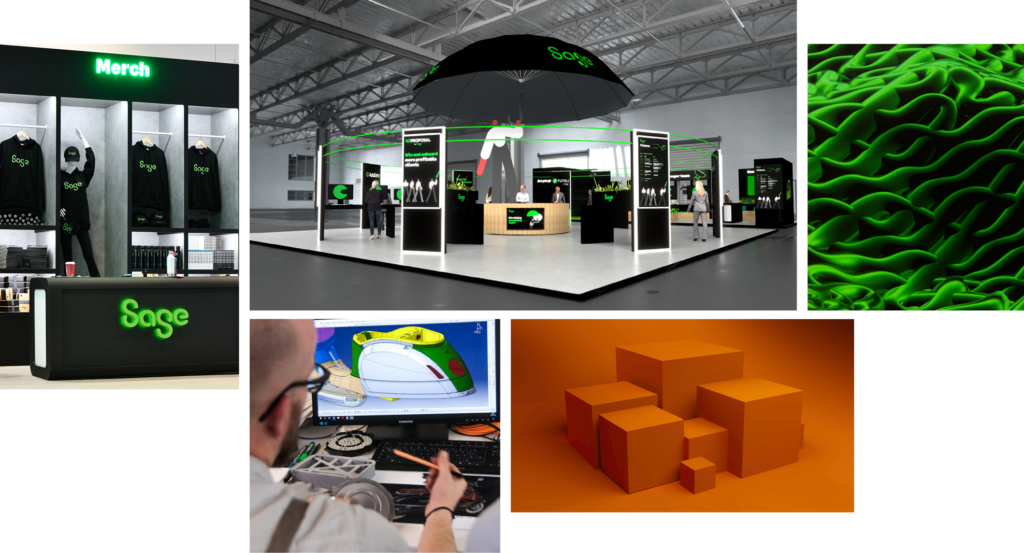
We’ve said it before, and we’ll say it again—it’s all about the research.
Endless hours of Googling have always been an inconsistent task, digging through out-of-date trends and questionable sources. AI now helps with quick-hit insights upfront. Working alongside creatives, project managers, and tech teams, AI can supply real-time data on location-specific options, costs, and availability. It’s not always perfect, but it provides a strong starting point to guide decision-making.
At the core of great trade stand management is human interaction. AI isn’t just about assisted search; it’s about enhancing engagement. The best agencies understand that leveraging AI effectively is key. No single tool does everything—it’s about stacking AI capabilities to enhance storytelling and interaction.
Some key AI-driven applications for on-stand content include:
At Outlook Creative, we see AI as a tool—a partner, not a replacement. It helps transform creative ideas into reality while keeping human insight at the core.
Craftsmanship, experience, and attention to detail are where agencies set themselves apart—core elements of effective trade stand management. There is nothing artificial about that.
Yes, the world of ‘digital twins’ and online congresses is exciting, but when it comes to the physical and human element—does anything really beat face-to-face interaction? Personally, I have yet to see AI’s direct impact on physical builds, but I’d love to hear others’ thoughts.
One critical point the entire creative industry must consider is sustainability—a topic that deserves an entire discussion of its own. AI requires massive amounts of power to function, and this should be factored into post-event sustainability reports. If we’re truly striving for greener events, this is something we can’t ignore.
AI isn’t replacing creativity—it’s reshaping how we work, unlocking new efficiencies, and challenging us to think differently. The best agencies will be the ones that embrace AI as an enabler, using it to refine ideas, enhance visualisation, and improve engagement.
At the end of the day, congresses and exhibitions are about connection—between brands and audiences, suppliers and partners, and ideas and execution. AI can enhance these connections, but it’s human creativity that brings them to life.
Want to see how AI can improve your next congress? Get in touch today to see how Outlook Creative can support you with design, trade stand management and everything in between.